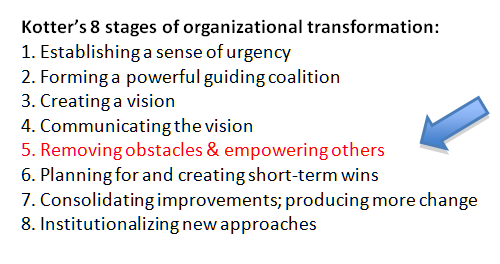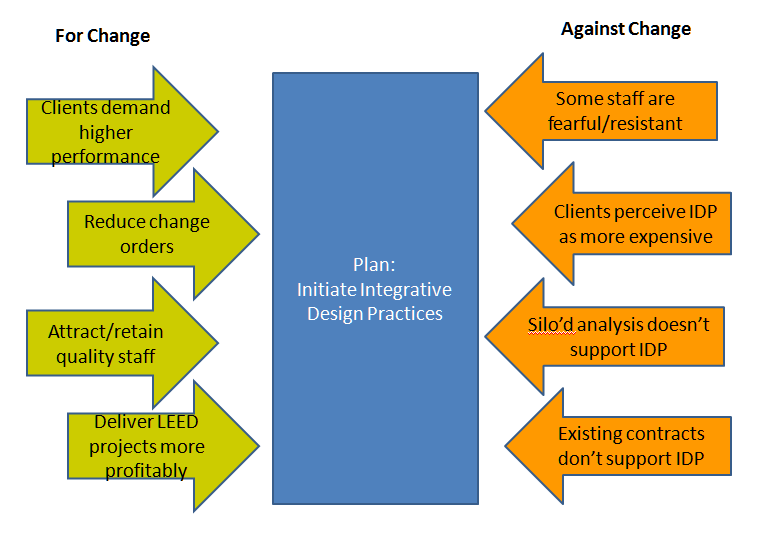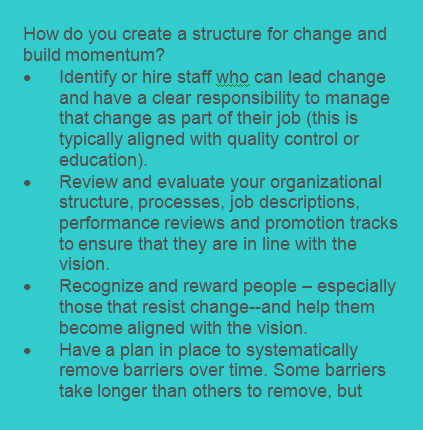In my first article in this series, “Putting the Management Back in Change“, I began looking at what it really takes for companies to get past a focus on LEED to successfully institutionalize sustainability and truly be “green firms”. In the series, I use Harvard business guru John Kotter’s 8 step model for organizational change as a framework to focus on sustainability. In subsequent articles, I discussed the need to create a sense of urgency, build guiding coalitions to create buy-in and grow momentum, develop a strong vision of where the company is headed, and communicate the vision effectively. In this article, I’ll focus on the importance of addressing barriers that could derail momentum.
The establishment of a ‘guiding coalition’ (see part 2) helps to gain buy-in and a communication plan (part 4) starts to set expectations. But there are always barriers that must be addressed before real, lasting progress can be made. One way to do this is to use “force field analysis,” a framework created by business guru Kurt Lewis. The analysis looks at driving forces and restraining forces that act on your goal state to determine the most effective way to upset equilibrium so that change can happen. Here is an example focused on the goal of instituting integrative design practices into a firm:
Either the driving forces need to be strengthened or the resisting forces need to be weakened. Frequently, removing the barriers (or resisting forces) is the most effective way to change the balance. I’ve included links to several force field analysis website at the end of this post.
What kind of barriers can derail good, early momentum?
What strategies work to overcome those barriers?
There are three kinds of barriers: structural, cultural, and psychological.
Structural barriers relate to functions in an organization that impact behavior. These may include company divisions, departments, design “studios” or working groups, hierarchical layers, reporting protocols, and systems (accounting, communication, standards, reporting). If the structure is the problem, trying to influence behavior won’t work unless you change the structure. For example: what if each division in a company has been judged independently on it profit margins, but now there is a desire for cross-collaboration between divisions? The incentives and metrics need to be re-evaluated to support overall profitability and encourage collaboration.
In our industry, LEED and 2030 present challenges to existing structures. The commitment to a higher level of health and performance of projects impacts both the behavior of staff internally, and the collaboration amongst the entire team. For a firm to successfully achieve higher performance on projects, it needs to re-design its design process and project management to remove barriers that impact analysis, decision-making and metrics. Contract structures may be altered, the timing of involvement and type of deliverables from consultants will change and different things will be tracked and measured, whether it’s recycled content or energy use.
For the 2030 Commitment, firms are tracking and reporting on the performance of their facilities and projects overall. This requires overcoming structural barriers related to systems and reporting so that the data can be collected and synthesized.
Cultural barriers: In companies with generally strong, healthy cultures, change happens more easily than in an organization with a weak or negative culture. Change is never easy, but people who feel valued, excited about their work and part of a ‘bigger vision’ in general get excited about any new evolution or development in that company’s endeavors. When office culture is weak and people don’t feel valued or part of a larger purpose, any “new” thing is viewed as a burden. If concepts of stewardship, responsibility, sustainability are not related to any core values of the company, or if collaboration, data or science-based analysis are foreign concepts – there will be cultural barriers to approaching a project with questions of performance and using analysis to refine the design approach.
In offices with weak or low morale sustainability can be used as a way of building up culture in general and bringing people together around a common purpose. A focus on sustainability can be the way that a firm begins to formulate their own methodology and approach, and clarify expectations about what to consider in each phase of a project and how to approach analysis. This can become a driving force that helps to establish a cultural norm and unifying identity.
Kotter advocates for encouraging some level of risk taking and nontraditional ideas, activities and actions as part of empowering others to achieve the vision. This can only happen if it becomes an explicit characteristic in office culture. Our interview with Chris Leary on the role of Disruptors in sustainability initiatives provides some useful examples of how to encourage and reward positive risk-taking.
Psychological barriers are different from cultural in that they define an individual’s thoughts and perceptions rather than the collective, group identity that culture refers to. Psychological barriers are difficult to address because they are often difficult to identify. Understanding the psychological barriers in company leaders is really important because they can be allies in change, or absolute barriers. An effort can go along smoothly and grind to a halt because a leader in the company (division head, etc) undermines new initiatives. This person may be paying lip services but not changing his/her personal behavior. In this case, lower level managers can feel that senior management has lied to them about their commitment and the whole effort can implode. On the other hand, staff at lower levels who work on projects can also become roadblocks if they aren’t on board.
Addressing leadership should be the first order of business. For example, one of the founding partners of a 120-employee Midwestern firm thinks he supports sustainable design and tells staff and clients that it’s important. Yet, he continually specifies glass curtain walls (even if they are south facing) and has not been willing or able to refine his design approach to incorporate analysis of interior lighting conditions, heat gain etc. Psychologically, he may be comfortable with OTHER “constraints” as a part of design process, but not scientific or evidence-based ones. Engaging this person one-on-one may be a route to influence his perceptions. Another approach might be to institute an office-wide design methodology (a structural change) that spells out what analysis must be done at each stage, what questions it should answer, etc. so a decision based on a personal preference for curtain walls would be not allowed.
It’s Complicated
As in the above example, structural, cultural and psychological barriers are often intertwined. What people think is always an underlying factor, and the impacts of collective identity are pervasive. You can address a cultural barrier, but if you don’t address individual mindsets, that won’t be enough. You can build up culture and increase buy-in, but if you leave structural barriers, people will give up.
Green teams are another approach that can cross all three categories. The creation of a green team is a structural solution but its functions impact culture and psychology. By providing quality control, integration and/or education, these teams can bridge multiple offices in a large firm, align disparate cultures and address individual mindsets. To fill these roles, however, they need to be an integral part of the management structure, rather than simply a group of like-minded volunteers.
As you formulate your strategies, you need to consider what barriers people are likely to face and then refine them accordingly. For example, if your company has many offices and each office is very independent and decentralized, then rolling out a top down, corporate-wide sustainability initiative is not likely to work. Instead, identifying 3 locations to pilot an initiative and growing it up from there may be more effective. If your architecture firm wants to achieve measurably higher project performance and you feel that your MEP consultant isn’t on the same page, you need to either find a new partner or work with your existing one to redefine how you work together—and that needs to be built into your strategy.
Influencing for change is not a one-size-fits-all activity. It’s important to tailor your approach to the individual situation. I recommend two resources that specifically address effective communication skills: Roger Fisher’s book, “Getting to Yes” and Robert Chialdini’s seminal work on the psychology of persuasion for guidance on different approaches, “Influence, The Psychology of Persuasion” (link?). http://www.influenceatwork.com
As always, the first step is to understand that committing to sustainability actually requires change and that change must be an intentional effort. Change can’t happen without addressing barriers. As you do that, you can also start to focus on short-term successes to pump up the energy and provide momentum –and that will be the focus of the next article.
Force Field Analysis Tools:


